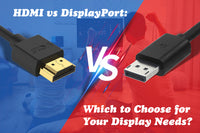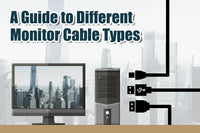Contents
Laptops and tablets are convenient to use as you can move to anywhere covered with Wi-Fi signals. Macs are favored by many people for their long shelf life, built-in security, and excellent performance. But MacBooks have a small screen size, and long-time staring at a small screen can cause discomfort. A monitor is needed for a good gaming, reading, and shopping experience. You may wonder how to connect the Mac to the monitor, and this blog will dive into the step-by-step guide.
What You’ll Need
Before any setup, you should prepare the following items:
- MacBook Computer: Make sure your MacBook can work well.
- External Monitor: Ensure the monitor is compatible with your MacBook computer.
- Cable or Adapter: Choose the right cable or adapter for different versions of MacBooks and monitors.
- A functional Workplace: Set up your monitor and Mac on a clean, stable surface with ample space.
MacBook Ports
MacBooks can have one or more external monitors, but different Macs have different ports. You should know what ports your MacBook has to find the correct cable or adapter. Apple uses a special port-Thunderbolt, which is different from other laptops. Thunderbolt was created by Intel and Apple. We’ll list ports of some MacBook models here:
Thunderbolt 1/2: Thunderbolt was first used on the 2011 MacBook Pro, and in 2013, Apple introduced Thunderbolt 2. The 2017 MacBook Air has two USB 3 ports and a Thunderbolt 2 port.
Thunderbolt 3: Thunderbolt 3 shares the same appearance as USB-C, and it can reach a bandwidth of 40 Gbit/s. Many Apple models feature the Thunderbolt 3 port.
- 13 in/ 15 in MacBook Air (2017)
- MacBook Air (2018)
- MacBook Air (2019)
- MacBook Air (2020)
- MacBook Pro (2018)
- MacBook Pro (2019)
- MacBook Pro (2020)
Thunderbolt / USB 4:
- MacBook Air M1 (2020)
- MacBook Pro M1 (2020)
- MacBook Air M2 (2022)
- MacBook Pro M2 (2022)
- MacBook Air M2 (2023)
Thunderbolt 4: There are no large differences between Thunderbolt 4 and Thunderbolt/USB 4. Thunderbolt 4 can reach a 40 Gbps bandwidth, while USB 4 stars from 20 Gbps bandwidth.
- MacBook Pro (2021)
- MacBook Pro (2023)
HDMI: 14-inch and 16-inch MacBook Pro models released after 2021 feature HDMI port
If you don’t know which ports your laptop has, click “About This Mac” and search for the MacBook serial number on Apple’s official website to know which kind of ports your Mac have.
Thunderbolt 1/2 vs. Mini DisplayPort
Mini DisplayPort was announced by Apple in 2008, and Thunderbolt is a successor of it. They share the same appearance, but there are slight differences between them. Thunderbolt is compatible with mini DisplayPort as it supports PCI-Express, but Thunderbolt 2 cannot be used for mini DP ports.
Thunderbolt 3 vs.USB-C
Thunderbolt 3 also shares the same appearance with USB-C. Thunderbolt 3 can do everything that USB-C can but is faster. Thunderbolt is the description of a type of high-speed data transmission. Thunderbolt 3 is backward-compatible with USB-C devices, but not all USB-C ports can support Thunderbolt.
Thunderbolt 4 vs. USB 4
Are Thunderbolt 4 and USB 4 the same? They are almost the same for their appearance. Thunderbolt 4 and USB 4 can transmit data at a bandwidth of up to 40 Gbps. Thunderbolt 4 officially supports USB 4. USB 4 is compatible with Thunderbolt 3 but cannot support Thunderbolt. Thunderbolt 4 is the winner as USB 4 is less stable and lacks consistency.
Choose the Right Cable and Adapter for MacBook
There are different monitor brands on the market and reliable brands are LG, Samsung, Acer, Dell, etc. Different monitors feature different ports, including HDMI, DVI, and DisplayPort. Ensure your monitor cable is compatible with your MacBook and the monitor. For example, if your MacBook uses Thunderbolt 3 port and your monitor uses HDMI Port, search Thunderbolt 3 to HDMI adapter on the search engine.

Display Setting Adjustment
How to connect your MacBook Pro 2017 to the Dell monitor? Here’s the step-by-step guide on how to adjust the display setting.
Step 1: Click the Apple icon in the top left of your laptop and then click System Preferences.

Step 2: Click Displays, and you can alter the display settings.

Step 3: Choose to mirror or extend your MacBook desktop on the monitor. Extending a MacBook desktop means your monitor is used as a separate desktop, while mirroring means you duplicate the MacBook’s screen on the monitor. You can choose mirror for a built-in display.

Step 4: You can also change the display resolution, rotation, refresh rate, and more in the display setting.

Step 5: If you have correctly connected your MacBook to the display, your Mac will detect the display automatically.
Recommended Adapter for MacBook
A wide range of adapters of different brands are available on the market for different MacBook models and monitors. Mini DP to HDMI, USB-C to DVI, USB to USB-C, and USB-C to HDMI are some examples. Always remember to purchase the adapters from well-known retailers, and you should read reviews to see if the adapter is compatible with your MacBook and monitor. If some users note that the adapter cannot work well for the same scenarios you need, choose another one.
For more information on this topic, you can keep up on our blogs. While VCELINK offers general and basic information for our customers and other visitors to the website, it’s not professional advice.



Be the first one to comment.
Leave a comment